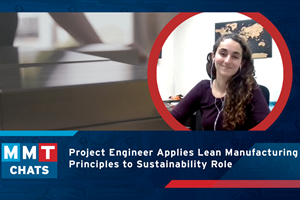Five Technologies Driving Competitiveness
Here are five technologies that can help mold manufacturers stay up-to-date to better compete in a global marketplace.
1. 3-D Product Modeling Streamlines Design Process
It all starts with streamlining the design process and there is always a bit of engineering and design before actual production can begin. CAD software automates much of the design process using preloaded templates and auto-snapping lines, contours and geometries. Having CAD software in place significantly decreases leadtimes, cost of production and the need for custom machine programming. Since most CAD programs interface with CAM systems, design specifications can be sent directly over to initiate production. This limits the need for retooling and automates toolpath programming.
2. Laser Cutting Tools Create Precision Parts
Some shops are beginning to make use of laser cutting machines to make precision and timely cuts. This technology isn’t radically new, but it’s only recently moved downstream to become affordable to smaller shops. Laser cutting systems are typically used in conjunction with a CAD program that guides high-speed streams of gas to make cuts across the material. In addition to making automated precision cuts, laser cutting technologies can handle multiple different materials, such as steel and aluminum.
3. Shop Floor Software Improves Efficiency
It’s also important to constantly track and monitor what’s happening on the shop floor, but many shops still operate by manual processes and record production metrics by pen and paper, which needless to say can lead to inaccuracies and inefficiencies. Job shop software delivers a variety of functionality that can help streamline workflow. This includes pulling up-to-date information for things like work in progress reports, bill of materials and lot tracking into a visual dashboard. The dashboard then provides production managers critical information to make effective decisions. Machine monitoring software can track and measure overall equipment effectiveness, such as the number of parts the machine produces per hour, machine availability and production control. With this level of information, managers make the small adjustments now that have can have a big impact on production down the line.
4. iPads Enable Workers to Be Mobile
These days, regardless of industry or size, organizations value the fact that employees have greater accessibility to the company—from virtually anywhere there’s a wireless connection. Beyond more traditional devices, like laptops and mobile phones, tablets like the iPad are changing the landscape for the mobile worker. The manufacturing industry has been slower to catch on to the iPad craze, mostly due to a lack of tablet durability. Slowly but surely, however, software integration to mobile tablets like the iPad is taking hold in the industry.
With this level of functionality in the mold shop, workers can track, monitor and report production in real time on the tablet—from wherever they are on the floor. For instance, an employee can report the labor time spent on a particular task and then view what’s next in the production queue to move onto the next task. Likewise, an employee that is working on a particular job can view work instructions for a project directly from their tablet. Managers can also roam the shop while maintaining access to mission critical data. They can use an iPad to determine how much more work needs to be done in a given day and how many employees are needed to finish the job. All of this leads to a more synchronized shop.
5. Outsource Marketing Muscle to Attract More Buyers
There is a growing trend in the use of outsourced marketing firms that act as middlemen to navigate the relationship between mold manufacturers and their customers. In order to maintain good relationships with customers, mold shops need to meet challenging leadtimes and narrow pricing parameters. Intense production scheduling can leave little room to manage things such as design, marketing and sales generation. Third-party marketing firms can help moldmakers manage these needs and grow the business while the shop fills orders. This not only allows the shop to focus on what it does best, making things, but also helps expand the sales channel to customers that might have been missed or never even considered.
For More Information:
For more information:
Job Shop Software Advice
(800) 918-2764 / (512) 364-0130
http://www.softwareadvice.com/manufacturing/job-shop-software-comparison/
Related Content
Think Safety: Eliminate Hazards Throughout the Shop
The tooling community is taking advantage of new products for safer mold shops and molding facilities.
Read MoreMMT Chats: Project Engineer Applies Lean Manufacturing Principles to Growing Sustainability Role
MoldMaking Technology Editorial Director Christina Fuges catches up with MMT’s 30-Under-30 Honoree Katherine Pistorius, who has added Regional Sustainability Coordinator alongside her Project Engineer duties, which demonstrates the many paths one can take in a manufacturing career. Here she shares how this opportunity unfolded for her and what the job entails today and in the future. This episode is brought to you by ISCAR with New Ideas for Machining Intelligently.
Read MoreShift in U.S. Mold Imports: Emerging Countries Gain Ground in Market Share
The dynamic nature of the U.S. mold industry's global trade landscape offers challenges and opportunities for growth.
Read MoreThe Critical Role of Management Representatives in ISO 9001
In ISO 9001 quality management systems, the Management Representative (MR) plays a crucial role. While the 2015 version of ISO 9001 no longer mandates this position, having a trusted management member serve as an MR remains vital for streamlining operations and maintaining quality standards.
Read MoreRead Next
How to Use Continuing Education to Remain Competitive in Moldmaking
Continued training helps moldmakers make tooling decisions and properly use the latest cutting tool to efficiently machine high-quality molds.
Read MoreReasons to Use Fiber Lasers for Mold Cleaning
Fiber lasers offer a simplicity, speed, control and portability, minimizing mold cleaning risks.
Read MoreAre You a Moldmaker Considering 3D Printing? Consider the 3D Printing Workshop at NPE2024
Presentations will cover 3D printing for mold tooling, material innovation, product development, bridge production and full-scale, high-volume additive manufacturing.
Read More










.jpg;maxWidth=300;quality=90)







